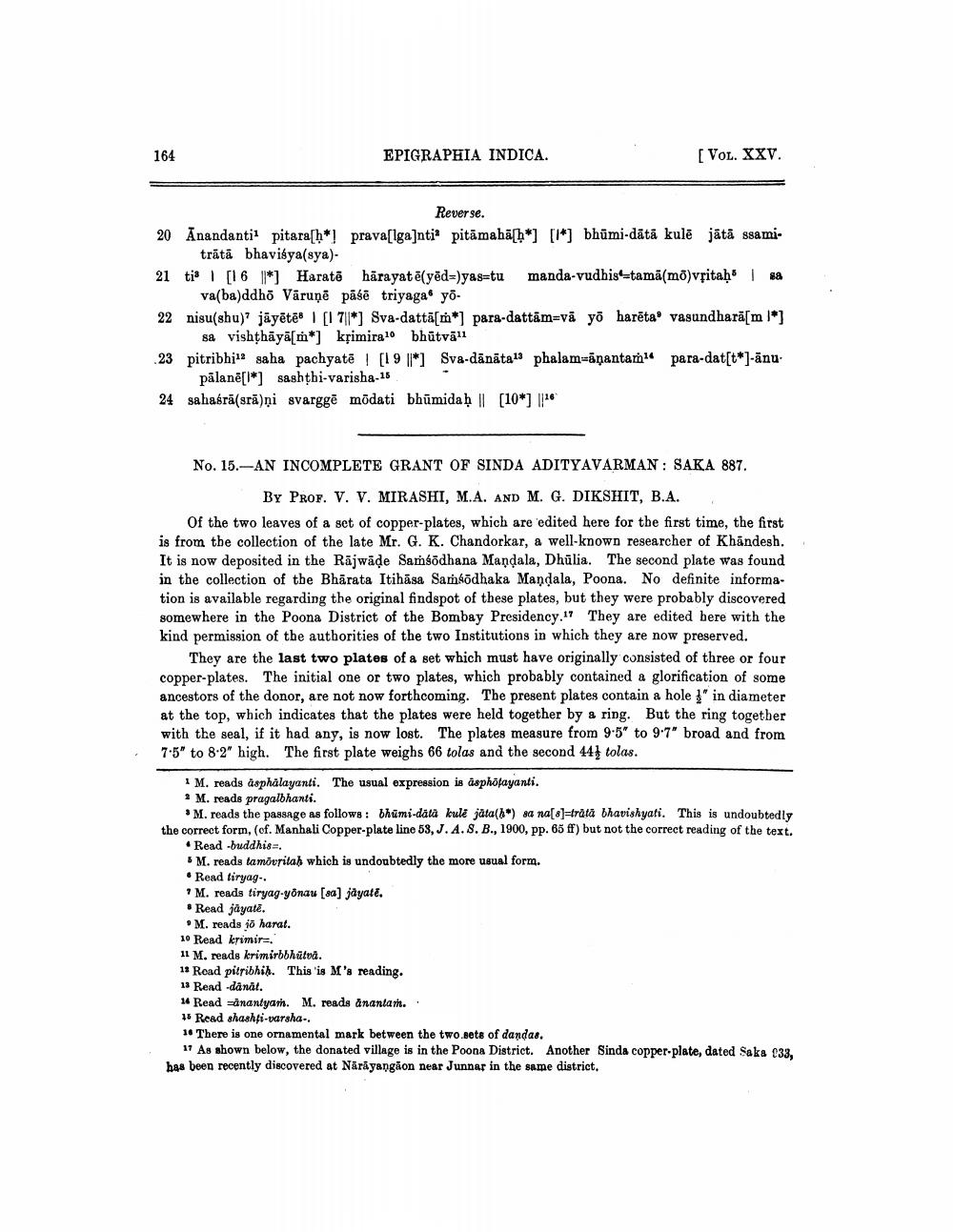________________
164
EPIGRAPHIA INDICA.
[Vol. XXV.
Reverse. 20 Anandanti pitara[h*! prava[lga]ntia pitāmahā[h*] [*] bhūmi-dātā kulē jātā ssami
trātā bhavisya(sya). 21 ti | [16]*] Haratē hārayatēlyēd=)yas=tu manda-vudbis-tamā(mő)vpitaḥ sa
va(ba)ddho Vāruņē pāśē triyaga yo22 nisu(shu)? jāyētēs | [1 7||*] Sva-dattā[**) para-dattām=vā yo harēta® vasundharā[m 1*]
sa vishthāyā[m*] krimiralo bhütvāli 23 pitribhi2 saha pachyatē ! [19 11*1 Sva-dānātala phalam=āņantam para-dat[t*]-ānu.
pālanē[l*] sashțhi-varisha-15 24 sahasrā(srā)ņi svarggē mödati bhūmidaḥ || [10*] ||
No. 15.-AN INCOMPLETE GRANT OF SINDA ADITYAVARMAN : SAKA 887.
By Prof. V. V. MIRASHI, M.A. AND M. G. DIKSHIT, B.A. Of the two leaves of a set of copper-plates, which are edited here for the first time, the first is from the collection of the late Mr. G. K. Chandorkar, a well-known researcher of Khandesh. It is now deposited in the Rājwāde Samsodhana Mandala, Dhūlia. The second plate was found in the collection of the Bhārata Itihäsa Samsodhaka Mandala, Poona. No definite information is available regarding the original findspot of these plates, but they were probably discovered somewhere in the Poona District of the Bombay Presidency.17 They are edited bere with the kind permission of the authorities of the two Institutions in which they are now preserved.
They are the last two plates of a set which must have originally consisted of three or four copper-plates. The initial one or two plates, which probably contained a glorification of some ancestors of the donor, are not now forthcoming. The present plates contain a hole }" in diameter at the top, which indicates that the plates were held together by a ring. But the ring together with the seal, if it had any, is now lost. The plates measure from 9:5" to 9.7" broad and from 7.5" to 8.2" high. The first plate weighs 66 tolas and the second 444 tolas.
1 M. reads asphalayanti. The usual expression is asphofayanti.
M. reads pragalbhanti.
M. reads the passage as follows: bhūmi-data kule jäta(h*) sa na[6]=trata bhavishyati. This is undoubtedly the correct form, (cf. Manhali Copper-plate line 53, J. A.8. B., 1900, pp. 65 ff) but not the correct reading of the text.
• Read -buddhisă.
M. reads tamõusitah which is undoubtedly the more usual form. • Read tiryag7 M. reads tiryag-yönau [sa] jayate. * Read jāyatē.
M. reads io harat. 10 Read krimira 11 M. reads krimirbbhūtva. 13 Road pitribhih. This is M's reading. 13 Read -danat. 14 Read =anantyan. M. reads anantan. 16 Read shashfi-varsha.. 14 There is one ornamental mark between the two sets of dandas.
17 As shown below, the donated village is in the Poona District. Another Sinda copper-plate, dated Saka 133. has been recently discovered at Nārāyangaon near Junnar in the same district.




